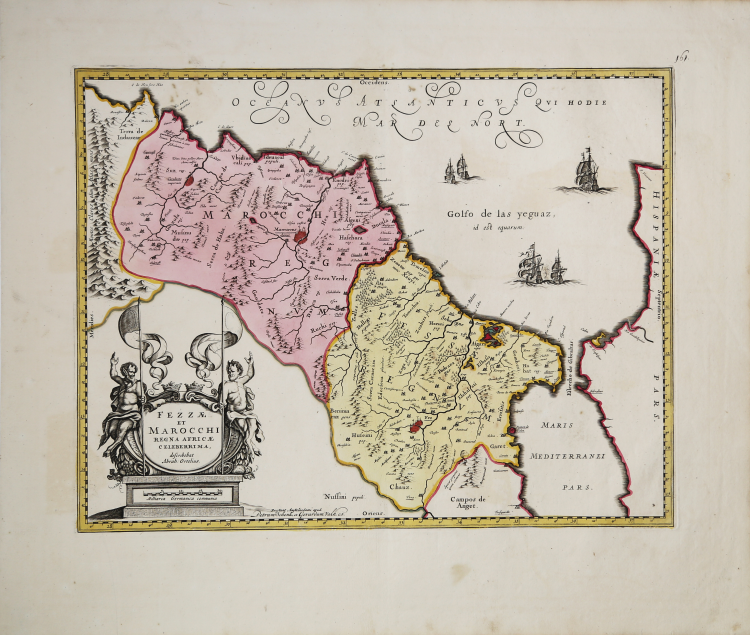




| Reference: | ms5035 |
| Author | Tipografia Valck & Schenk |
| Year: | 1705 ca. |
| Zone: | Morocco |
| Printed: | Amsterdam |
| Measures: | 500 x 390 mm |



| Reference: | ms5035 |
| Author | Tipografia Valck & Schenk |
| Year: | 1705 ca. |
| Zone: | Morocco |
| Printed: | Amsterdam |
| Measures: | 500 x 390 mm |
A striking map of Morocco, showing large fortified towns of Marrakesh, Taroudant and Fez, towns, mountains, rivers, lakes, etc. Tanger, Cueta and Rio Rabata also appear.
Large decorative cartouche and sailing ships. Ortelius is credited in the title as the map source.
Map taken from "Atlantis sylloge compendious or Nova totius Geographia" published in Amsterdam in the early eighteenth century (around 1705).
This is the same copperplate printed by Joannes Janssonius in 1645, with only the addition of the geographic grid and the change of the editorial imprint, which becomes "apud G. Valk et P. Schenk." The graphic reticle has a half-degree scan. The dating, as well as the provenance of such a chart, i.e. the inclusion of such a chart in an atlas, is very problematic. Petrus Schenk I (c. 1660-1718) was a German engraver and publisher who moved to Amsterdam at a very young age where he became a pupil of Gerad Valk (1656-1726) and whose sister Agatha he married in 1687. The association between the two dates back as early as the early 1680s; around 1690 they happened to acquire most of Janssonius's copperplates, which were edited by them with minor retouches and modifications.
Copper engraving, coloring coeval, in excellent condition.
Tipografia Valck & Schenk (attiva 1687 - 1711 circa)
|
Gerard Valk, or Gerrit Leendertsz Valck (1652-1726) together with his son Leonard, were the only significant publishers of globes in the Netherlands in the eighteenth century, enjoying an almost total monopoly in the first half of the 1700's. Initially an engraver and art dealer and having worked for map-sellers Christopher Browne and David Loggan in London between 1672 and 1679, Valk established the firm in Amsterdam in 1687. Initially, they published maps and atlases, but in 1700 the company moved the shop to the building previously occupied by map and globe-maker Jodocus Hondius. Around 1711, when he became a member of the bookseller's guild, Leonard Valk (1675-1746) came into partnership and his name started to appear alongside that of his father on the cartouches of the globes, although the earliest of these, both terrestrial and celestial, still bear the date 1700. Leonard naturally took over the business on his father's death in 1726 and following his own death in 1746 the firm was run by Maria Valk, cousin, and wife to Gerard.
Peter Schenk the Elder (1660-1711) moved to Amsterdam in 1675 and began to learn the art of mezzotint. In 1694 he bought some of the copperplate stock of the mapmaker Johannes Janssonius, which allowed him to specialize in the engraving and printing of maps and prints. He split his time between his Amsterdam shop and Leipzig and also sold a considerable volume of materials to London. Peter Schenk the Elder had three sons. Peter the Younger carried on his father’s business in Leipzig while the other two, Leonard and Jan, worked in Amsterdam. Leonard engraved several maps and also carried on his father’s relationship with engraving plates for the Amsterdam edition of the Histoire de l'Académie Royale des Sciences.
|
Tipografia Valck & Schenk (attiva 1687 - 1711 circa)
|
Gerard Valk, or Gerrit Leendertsz Valck (1652-1726) together with his son Leonard, were the only significant publishers of globes in the Netherlands in the eighteenth century, enjoying an almost total monopoly in the first half of the 1700's. Initially an engraver and art dealer and having worked for map-sellers Christopher Browne and David Loggan in London between 1672 and 1679, Valk established the firm in Amsterdam in 1687. Initially, they published maps and atlases, but in 1700 the company moved the shop to the building previously occupied by map and globe-maker Jodocus Hondius. Around 1711, when he became a member of the bookseller's guild, Leonard Valk (1675-1746) came into partnership and his name started to appear alongside that of his father on the cartouches of the globes, although the earliest of these, both terrestrial and celestial, still bear the date 1700. Leonard naturally took over the business on his father's death in 1726 and following his own death in 1746 the firm was run by Maria Valk, cousin, and wife to Gerard.
Peter Schenk the Elder (1660-1711) moved to Amsterdam in 1675 and began to learn the art of mezzotint. In 1694 he bought some of the copperplate stock of the mapmaker Johannes Janssonius, which allowed him to specialize in the engraving and printing of maps and prints. He split his time between his Amsterdam shop and Leipzig and also sold a considerable volume of materials to London. Peter Schenk the Elder had three sons. Peter the Younger carried on his father’s business in Leipzig while the other two, Leonard and Jan, worked in Amsterdam. Leonard engraved several maps and also carried on his father’s relationship with engraving plates for the Amsterdam edition of the Histoire de l'Académie Royale des Sciences.
|